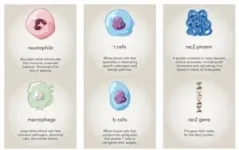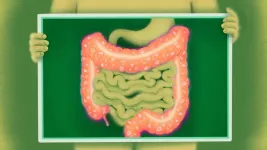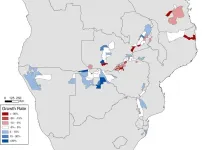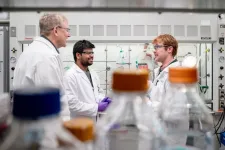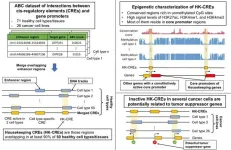(Press-News.org) (Santa Barbara, Calif.) — Scientists have solved a cellular murder mystery nearly 25 years after the case went cold. Following a trail of evidence from fruit flies to mice to humans revealed that cannibalistic cells likely cause a rare human immunodeficiency. Now the discovery shows promise for enhancing an up-and-coming cancer treatment.
“This paper takes us from very fundamental cell biology in a fly, to explaining a human disease and harnessing that knowledge for a cancer therapy,” said UC Santa Barbara’s Denise Montell. “Each one of those steps feels like a major discovery, but here they are, all in one paper.”
Researchers in Montell’s lab published their findings in the Proceedings of the National Academy of Sciences and are now investigating the mechanisms and implications.
An ancient gene
The primary character in this story is a gene, Rac2, and the protein it encodes. Rac2 is one of three Rac genes in humans. “Rac is very ancient in evolution, so it must serve a fundamental function,” said senior author Montell, Duggan Professor and Distinguished Professor of Molecular, Cellular, and Developmental Biology.
Rac proteins help build a cell’s scaffolding, called the cytoskeleton. The cytoskeleton is made of dynamic filaments that allow cells to maintain their shape or deform, as needed. In 1996, while studying a small group of cells in the fruit fly ovary, Montell determined that Rac proteins are instrumental in cell movement. Since then, it has become clear that Rac is a nearly universal regulator of cell motility in animal cells.
Back in the ‘90s, she noticed that a hyperactive form of the Rac1 protein, expressed in only a few cells in a fly’s egg chamber, destroyed the whole tissue. “Just expressing this active Rac in six to eight cells kills the entire tissue, which is composed of about 900 cells,” explained lead author Abhinava Mishra, a project scientist in Montell’s lab.
Why did this happen? How does it work? “This was our 25-year-old cold case,” Montell said.
A few years ago, evidence began to mount implicating cell eating, also known as cannibalism, in tissue destruction. There’s a step in normal fly egg development where certain cells similar to the border cells consume their neighbors because they are no longer needed. Indeed, cellular cannibalism is not as rare as you might expect: Millions of old red blood cells are eliminated from the human body this way every second.
Rac2 is one component of the complex eating process. Rac helps the eating cell to envelop its target. The team was curious if a hyperactive form of the protein was causing border cells to prematurely consume their neighbors.
For this to occur, the border cells need to recognize their targets, which requires a particular receptor. Indeed, when Mishra blocked this receptor, the border cells expressing activated Rac didn’t consume their neighbors, and the egg chamber remained alive and healthy.
“Our 25-year-old cold case was solved, and that was very satisfying for us,” Montell exclaimed. “But this is a fairly niche area of Drosophila egg development.” The implications would soon grow, though.
A mysterious immune condition
Around the time that her lab made their breakthrough, Montell caught wind of an intriguing study in the journal Blood. This paper found that three unrelated people suffering from recurrent infections had the exact same mutation, which hyperactivates Rac2, a Rac protein produced in blood cells. She suspected her lab’s recent revelation in fruit flies might shed light on this enigma.
The patients’ mutation was just mildly activating, and yet it was enough that they all suffered from multiple infections and ultimately needed bone marrow transplants. Blood tests revealed that these patients had nearly no T cells, a specialized kind of white blood cells crucial to the immune system. The team at the National Institutes of Health inserted the Rac2 mutation into mice and found the same mysterious loss of T cells. They also found that the T cells with hyperactive Rac developed normally in the animals’ bone marrow, and migrated to the thymus, where they continued to mature without incident. But then they just seemed to disappear. So, the paper ended with a mystery: what was causing the T cells to disappear?
The authors of that journal study had noticed that many of the patients’ neutrophils — another type of white blood cell — were enlarged. They seemed to be consuming quite a lot of material, unusual behavior in an otherwise healthy person.
Montell wondered if the patients’ T cells were disappearing because their innate immune cells like neutrophils with active Rac2 were eating them, much like the fruit fly border cells with active Rac were eating the egg chamber. Her team turned their attention to macrophages — the neutrophil’s more voracious counterpart — to investigate. Mishra cultured human macrophages with and without hyperactive Rac2 together with T cells. He observed that macrophages with hyperactive Rac consumed more cells, confirming the group’s hypothesis from their work with fruit flies.
To test whether this might cause the observed immunodeficiency, co-author Melanie Rodriguez (a graduate student in Montell's lab) took bone marrow samples from mice with the same hyperactive Rac2 mutation found in the patients. She then grew the marrow stem cells into macrophages, and performed a similar experiment to Mishra, but this time mixing both macrophages and T cells with and without the Rac2 mutation.
She found that macrophages with active Rac2 consumed significantly more T-cells than their normal counterparts. However, T-cells with active Rac2 were also more vulnerable to consumption from either kind of macrophage. So the most likely explanation for the patients’ missing T cells was a combination of increased consumption by macrophages as well as increased vulnerability of the T cells themselves. A human medical mystery was solved based on fundamental observations in fruit flies.
Harnessing haywire cells
The implications of these insights expanded in January 2020, when co-author Meghan Morrissey interviewed for a faculty position at UCSB. In her talk she described programming macrophages to eat cancer cells as a novel treatment for the disease, an approach called CAR-M. Morrissey had found that adding a CAR receptor to macrophages promoted this behavior. But it was also clear that inducing the macrophages to eat more would make the approach more effective — especially if they would specifically consume, and kill, entire cancer cells .
Well, if there was one thing that Montell and her lab had learned, it was how to make macrophages eat and kill whole, living cells. So they collaborated with Morrissey, now an assistant professor of molecular, cellular and developmental biology, to determine if adding activated Rac2 would increase the effectiveness of the CAR-M approach.
Rodriguez grew macrophages from the bone marrow of normal and mutant mice with activated Rac2. In each of these groups, Morrissey expressed either a dummy receptor or the CAR receptor, which recognizes B cells (another type of white blood cell). They found that the normal and hyperactive Rac cells with the dummy receptors did not eat many B cell targets. The normal macrophages with CAR receptors consumed far more B cells, as Morrissey had previously shown. However the macrophages with both hyperactive Rac and the CAR receptors ate twice-again as many B cells as the CAR-only group. Activated Rac2 also seemed to increase the number of so-called “super eaters” — ravenous macrophages that eat and kill multiple cancer cells.
The results made it clear that activated Rac and the receptor were both necessary for the enhanced effect. “If you add active Rac without the right receptor, it doesn’t do anything,” Montell explained.
This level of control is good news for any potential treatments, because it would give doctors a way to focus the modified macrophages’ attack on cancerous cells. Clinicians hopefully won’t need to worry about the engineered cells eating the patient’s T-cells either, because the T-cells wouldn’t have the active Rac2 mutation making them more vulnerable to this, as Rodriguez had previously discovered.
There is a current cancer treatment called CAR-T, which uses the CAR receptor and a patient’s own T-cells to attack and destroy cancers. It is highly effective against some cancers, but there are many that do not respond. CAR-M,a newer cousin to CAR-T, has recently entered into clinical trials in humans and so far seems safe. Montell and her group are interested in harnessing Rac-enhanced CAR macrophages to increase the efficacy of CAR-M treatments. They’ve filed a provisional patent for the technique — which they call RaceCAR-M — and are inviting biotech companies to partner in further developing the approach.
This new multifaceted paper raises both basic science and practical questions, which the lab has begun to tackle. They’re investigating whether the technique, which is so effective in the lab, will also work in freshly collected human immune cells and in animal cancer models, in mice and zebrafish. The team is also exploring how Rac2 is making this all happen at the molecular level, deep inside the cells.
Further down the line, Montell wants to know how many kinds of cancer the RaceCAR-M treatment might successfully target. For comparison, CAR-T has been effective against cancers like leukemia and lymphoma, but not against solid-tumor cancers like breast, lung or colon.
The results have amazed Montell, an esteemed cell biologist with well over 100 papers to her name. “This is my favorite paper so far,” she said.
“We had this 25-year-old cold case in fruit flies, and we solved it,” Montell added. “And that helped us solve the mystery of an unexplained human immunodeficiency. And then we harnessed that knowledge to enhance a potential cancer immunotherapy.
“It was just one mystery after another, and Rac turned out to be the answer to each of them.”
You can hear more about the path from fruit flies to potential cancer treatment in Montell’s SNPets interview with the Genetics Society of America, episodes 4-6.
END
When bad cells go good: Harnessing cellular cannibalism for cancer treatment
A cellular murder mystery in fruit flies explains a human immunodeficiency, with applications for immunotherapy
2024-01-05
ELSE PRESS RELEASES FROM THIS DATE:
Researchers identify why cancer immunotherapy can cause colitis
2024-01-05
Researchers at the University of Michigan Health Rogel Cancer Center have identified a mechanism that causes severe gastrointestinal problems with immune-based cancer treatment.
They also found a way to deliver immunotherapy’s cancer-killing impact without the unwelcome side effect.
The findings are published in Science.
“This is a good example of how understanding a mechanism helps you to develop an alternative therapy that’s more beneficial. Once we identified the mechanism causing the colitis, we could then develop ways to overcome this problem and prevent colitis while preserving the anti-tumor effect,” said senior ...
JNM publishes procedure standard/practice guideline for FES PET imaging of breast cancer
2024-01-05
Reston, VA — The Society of Nuclear Medicine and Molecular Imaging (SNMMI) and the European Association of Nuclear Medicine (EANM) have issued a new procedure standard/practice guideline for estrogen receptor imaging of breast cancer patients using FES PET. The standard/guideline, published ahead of print in The Journal of Nuclear Medicine, is intended to assist physicians in recommending, performing, interpreting, and reporting the results of 18F-FES PET studies for patients with breast cancer.
More than two million women worldwide are diagnosed with breast cancer ...
Can we fight back against Parkinson’s disease? These research volunteers hope so
2024-01-05
About three years before he retired, David Campbell noticed something weird happening as he typed. Whenever he tried to hit a letter, say “a,” he’d get “aaa,” like the keyboard was jamming or his finger was triple-tapping the key. That wasn’t the only thing that seemed off—his sense of smell was faltering. “Little things,” he says, “that I didn’t think of as being a big deal.”
A couple of weeks after he retired in fall 2020, Campbell learned the little things weren’t ...
After COP28 “insider” climate activists will become increasingly important, study suggests.
2024-01-05
Climate campaigners will increasingly adopt “insider activist” roles, working to change or challenge their organisations from the inside rather than the outside, a new study says.
Research led by the University of Exeter identifies different types of climate activists. As well as “insiders”, there are others who seek to undermine, or even damage, climate-recalcitrant organisations they are members of in the hope of change.
The study says the growing climate backlash against traditional outside climate activism and rise of corporate “greenwashing” means collaborating or ...
Protected areas for elephants work best if they are connected
2024-01-05
PRETORIA, SOUTH AFRICA – Conservation measures have successfully stopped declines in the African savanna elephant population across southern Africa, but the pattern varies locally, according to a new study.
The evidence suggests that the long-term solution to elephant survival requires not only that areas are protected but that they are also connected to allow populations to stabilize naturally, an international research team says.
Their study, published on January 5th in the peer-reviewed journal Science Advances, collected survey estimates and calculated growth rates for ...
Cult mentality: SLU professor makes monumental discovery in Italy
2024-01-05
Douglas Boin, Ph.D., a professor of history at Saint Louis University, made a major announcement at the annual meeting of the Archeological Institute of America, revealing he and his team discovered an ancient Roman temple that adds significant insights into the social change from pagan gods to Christianity within the Roman Empire.
“We found three walls of a monumental structure that evidence suggests belonged to a Roman temple that dates to Constantine's period,” Boin said. “It dates to the fourth century AD and it would ...
Inhalable sensors could enable early lung cancer detection
2024-01-05
CAMBRIDGE, MA -- Using a new technology developed at MIT, diagnosing lung cancer could become as easy as inhaling nanoparticle sensors and then taking a urine test that reveals whether a tumor is present.
The new diagnostic is based on nanosensors that can be delivered by an inhaler or a nebulizer. If the sensors encounter cancer-linked proteins in the lungs, they produce a signal that accumulates in the urine, where it can be detected with a simple paper test strip.
This approach could potentially replace or supplement the current gold standard for diagnosing lung cancer, low-dose computed tomography (CT). It ...
A new approach can address antibiotic resistance to Mycobacterium abscessus
2024-01-05
(Memphis, Tenn.—January 5, 2024) Scientists at St. Jude Children’s Research Hospital are tackling Mycobacterium abscessus (Mab) antibiotic resistance. This naturally antibiotic-resistant pathogen is becoming more prevalent, highlighting the urgent need for novel therapeutics. To address this, the scientists designed new versions of the drug spectinomycin that overcome efflux, the main mechanism driving resistance. The work was published today in Proceedings of the National Academy of Science.
Mab infections are increasingly found ...
nTIDE December 2023 Jobs Report: People with disabilities maintain strong employment levels through end of year, staying at historic highs
2024-01-05
East Hanover, NJ – January 5, 2023 – Following a historic high in November, slight declines were seen in the employment-to-population ratio and the labor force participation rate in December 2023 for people with and without disabilities. However, numbers still remain near the record levels achieved the previous month, according to today’s National Trends in Disability Employment – semi-monthly update (nTIDE), issued by Kessler Foundation and the University of New Hampshire’s Institute on Disability (UNH-IOD).
Month-to-Month nTIDE Numbers (comparing November 2023 to December 2023)
Based on data from the U.S. Bureau of Labor Statistics (BLS) Jobs ...
New study reveals crucial 'housekeeping' genetic elements and their potent role to fight cancer
2024-01-05
Technological advancements have enabled scientists to comprehensively explore genetic control elements, unraveling the complexities of gene activation mechanisms in our genetic code. New evidence challenges the simplistic view that cis-regulatory elements (CREs) are mere on/off switches for genes, emphasizing their ability to exhibit complex behaviors, such as the simultaneous enhancement of gene activity and initiation of gene transcription, e.g., simultaneous enhancer and promoter activities. These switches aren't only important for the enhancement ...
LAST 30 PRESS RELEASES:
New study shows how the spleen helps the immune system accept a transplant
New Mayo Clinic study advances personalized prostate cancer education with an EHR-integrated AI agent
Researchers identify novel therapeutic target to improve recovery after nerve injury
Microbes in breast milk help populate infant gut microbiomes
Reprogramming immunity to rewrite the story of Type 1 diabetes
New tool narrows the search for ideal material structures
Artificial saliva containing sugarcane protein helps protect the teeth of patients with head and neck cancer
Understanding the role of linear ubiquitination in T-tubule biogenesis
Researchers identify urban atmosphere as primary reservoir of microplastics
World’s oldest arrow poison – 60,000-year-old traces reveal early advanced hunting techniques
Bristol scientists discover early sponges were soft
New study uncovers how rice viruses manipulate plant defenses to protect insect vectors
NSF–DOE Vera C. Rubin Observatory spots record-breaking asteroid in pre-survey observations
Ribosomal engineering creates “super-probiotic” bacteria
This self-powered eye tracker harnesses energy from blinking and is as comfortable as everyday glasses
Adverse prenatal exposures linked to higher rates of mental health issues, brain changes in adolescents
Restoring mitochondria shows promise for treating chronic nerve pain
Nature study identifies a molecular switch that controls transitions between single-celled and multicellular forms
USU chemists' CRISPR discovery could lead to single diagnostic test for COVID, flu, RSV
Early hominins from Morocco reveal an African lineage near the root of Homo sapiens
Small chimps, big risks: What chimps show us about our own behavior
We finally know how the most common types of planets are created
Thirty-year risk of cardiovascular disease among healthy women according to clinical thresholds of lipoprotein(a)
Yoga for opioid withdrawal and autonomic regulation
Gene therapy ‘switch’ may offer non-addictive pain relief
Study shows your genes determine how fast your DNA mutates with age
Common brain parasite can infect your immune cells. Here's why that's probably OK
International experts connect infections and aging through cellular senescence
An AI–DFT integrated framework accelerates materials discovery and design
Twist to reshape, shift to transform: Bilayer structure enables multifunctional imaging
[Press-News.org] When bad cells go good: Harnessing cellular cannibalism for cancer treatmentA cellular murder mystery in fruit flies explains a human immunodeficiency, with applications for immunotherapy

